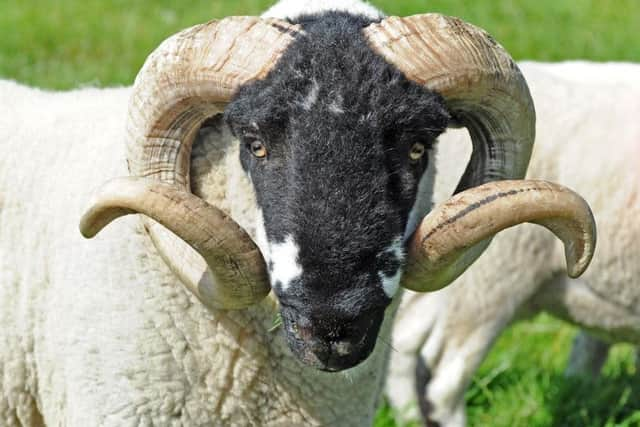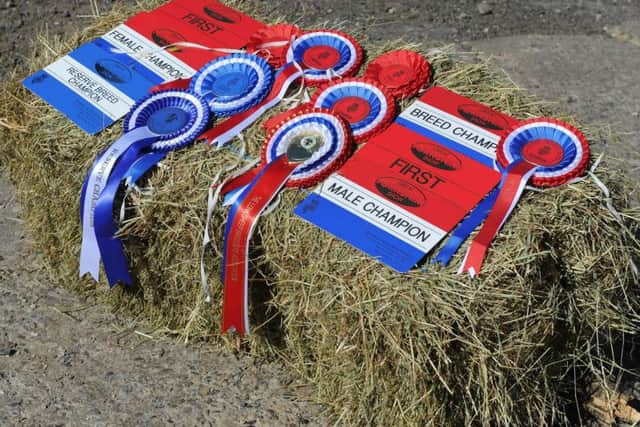How farmer near Holmfirth trumped Lancastrian rivals with sheep of their own


From here in West Yorkshire or one of the outposts of the old West Riding, well-respected sheep breeder Clive Mitchell can see the neighbouring counties of Derbyshire and Lancashire where his two main sheep breeds emanate.
Advertisement
Hide AdAdvertisement
Hide AdDerbyshire Gritstones, Lonks, that are regarded as a Lancashire breed, and Whitefaced Woodlands, known as the Penistone sheep, are all part of Clive’s pure breed mix that sees him with around 150 breeding ewes of both the Gritstones and Lonks and a smaller number of Woodlands.


Clive has won many breed championships at summer agricultural shows and earlier this month had one of his best results at the Great Yorkshire Show when carrying off the breed champion award with his Lonk tup and reserve champion as well as female champion with his Derbyshire Gritstone ewe.
While the courage and bravery required some years ago when taking on the Lonk breed’s show hierarchy is definitely over-egging things a little, for the point of emphasis there is a serious side too. Rather like someone new coming on the scene in jam or chutney making in a local show, Clive’s success with the Lancastrian breed specifically in their own heartland is the stuff of legend.
“Years ago when I first started with Lonks and went to the Lonk breed show at Holme in Cliviger near Burnley one local farmer told me I wouldn’t win a thing against the top four breeders and he was quite right, but I kept persevering with the job and going along each year. Then, a few years ago I had breed champion two years in succession. That’s when the same farmer came to me and said ‘I think you’ve infiltrated them’.
Advertisement
Hide AdAdvertisement
Hide Ad“I’ve always liked their power and they lamb easily. They’re pretty good at living higher up too. The Derbyshire Gritstones have always been a passion going back to my grandad’s day, but the Lonks and the Gritstones are now both my passion. They both have their qualities with the Gritstones being a more marginal hill sheep than the Lonk.


“I started with the Gritstones when my grandad, George Henry Mitchell, died. He’d told my dad George, my uncle Harold and his son Trevor that we could all have the pick of his flock and I chose a ewe with two tup lambs. I remember my dad saying I should have picked the one with two gimmer lambs, but I built up from that start.”
Production of tups that average between £500 to £800 sold through breed society sales at Clitheroe livestock market for the Gritstones and Lonks and at Holmfirth livestock market for the Woodlands form a major part of Clive’s livelihood. His top price received so far has been £4,500 at Clitheroe.
Advertisement
Hide AdAdvertisement
Hide Ad“I get rid of anything that’s not up to breed standard as store or fat lambs at Holmfirth, and keep the best for replacements, selling a few shearling ewes if I’ve kept too many. Occasionally, I might get asked for one or two ewes that will do another turn. Largely my ewes will do four crops, unless I have something special that keeps giving a good tup.
“We start lambing around April 12-15. Years ago that would have been around two weeks later. All lambing is outside unless there’s one that needs to be watched over.
“I get one cut of grass for haylage and normally buy in quite a bit of fodder and fodder beet, but in recent times I’ve started reseeding with ryegrasses and it has made a heck of a difference with the grass growing a lot better.
“I have a really good local agricultural contractor, Stuart Oldfield, who supplies me with fodder beet. He never lets me down. If he runs out of his own stock he will go out of his way to get some from someone else.”
Advertisement
Hide AdAdvertisement
Hide AdClive’s farming operation runs to around 200 acres with land owned and rented at Coldwell Farm and elsewhere. He had a small herd of Charolais cattle until two years ago when he had a heart attack.
“My son Joe said I should get rid of them. It’s funny but it should have saved me some work yet I still manage to fill every day. It is better without having to deal with them though.”
The move has certainly proved successful given this year’s results at Harrogate where Clive’s beaming smile was very much in evidence as he received yet more rosettes. He thinks fondly of a previous occasion when he also had breed champion with a Derbyshire Gritstone.
Advertisement
Hide AdAdvertisement
Hide Ad“We used to like celebrating, particularly myself and my sadly passed away mate, Ewan Brown. I remember one time when Ewan took the tup out on the halter for a walk around the showground like walking a dog. Hours later he came back much the worse for wear and with the tup walking behind him, but with no halter on at all.
“I had an old Land Rover at one time with a canvas roof and I’d do the normal thing of loading up the sheep in the trailer, but that same tup used to get in the back of the pick-up and he’d stand with his head over my shoulder as I was driving.”
Clive recalls his dad being sheepdog-mad. “He’d be off anywhere in the country, sheepdog trials were all he had in his head, it didn’t matter about anything else. He was on One Man & His Dog on television. I keep dogs to keep sheep in, father would keep sheep to train his dogs.”
Clive shows his sheep at no more than a handful of summer shows including his local show at Harden Moss, the Great Yorkshire, Hope Show at the end of August – and next Saturday’s Halifax Show.
Advertisement
Hide AdAdvertisement
Hide AdHe and his wife, Susan, have a son, Joe, and daughter, Jamie, who has two children, William and Olivia.
“William is 11 and is farming mad. He has his own flock of Herdwicks and is already well-known for them. Watch out for him in the future. He did well at Harrogate too.”